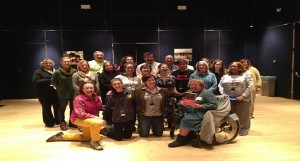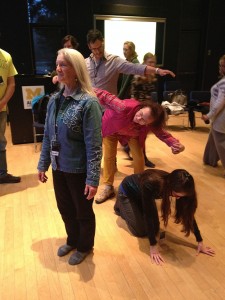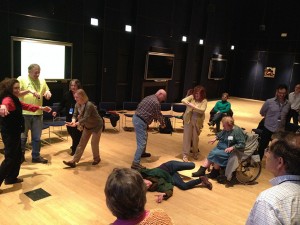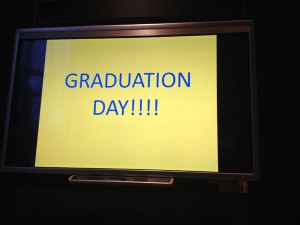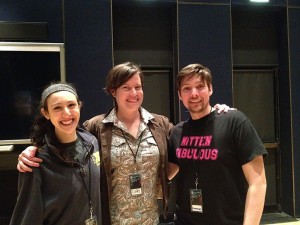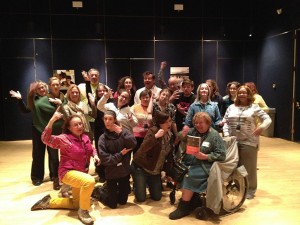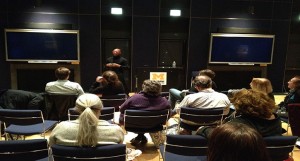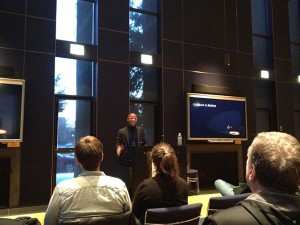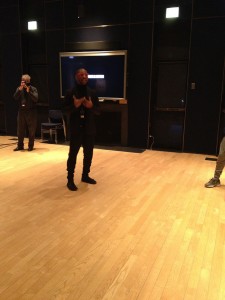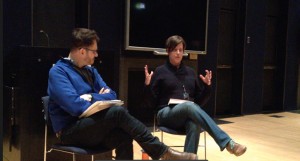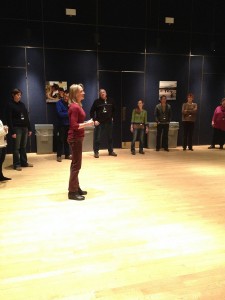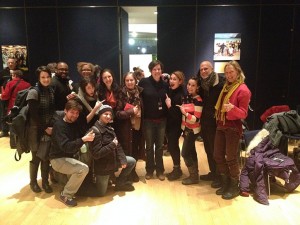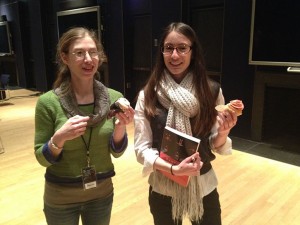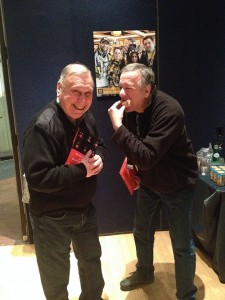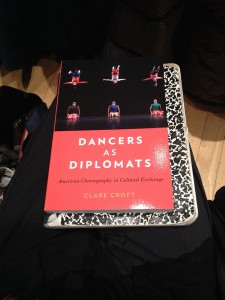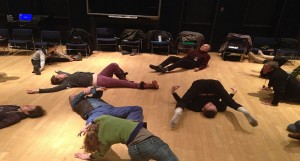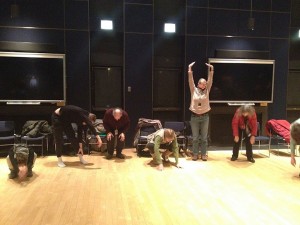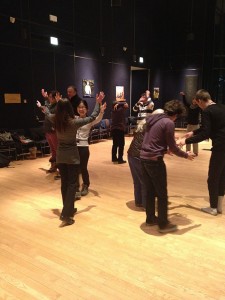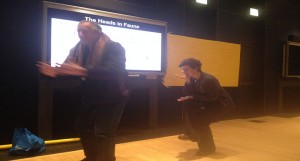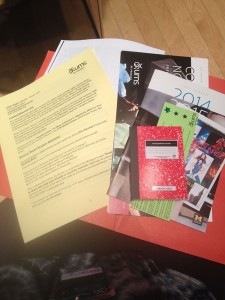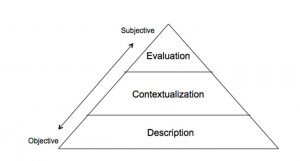UMS Night School: Curious About Dance – Session 5 Recap
Editor’s note: This post is a part of a series by U-M student and UMS intern Hillary Kooistra, who’s covering our free UMS Night School: Curious About Dance workshop series.
Moving Forward
This past Monday evening, our last Night School session of the year, we celebrated an enriching, inspiring, and fun-filled five weeks by reflecting on our past lessons and looking toward future engagement opportunities. The time has flown and I cannot believe how quickly Graduation Day arrived, but before we could break out the Pomp and Circumstance, we had a stunning weekend of dance to unpack! We began our session with an exercise and discussion around this past weekend’s Abraham.In.Motion performances, then transitioned to wrapping up the entire semester. Over the course of the evening, we moved from speaking specifically about one company’s work to thinking in general terms about dance we’ve seen this season and will see in the future; once again proving that though there are infinite ways to approach movement exploration and discussion, similar concepts appear and circulate among these seemingly different dance works.
We began our session a bit differently on Monday night. Instead of sharing and repeating gestures, laughing at one another’s creativity or manipulating the movement we perceived; we stood in our circle with closed eyes. Checking in with ourselves and becoming comfortable in the space, we freed our bodies and minds to think about this past weekend’s double bill. When we opened our eyes, we assumed a pose that reflected a particular moment of resonance from either Friday or Saturday night’s performance. Instead of teaching and repeating one another’s poses, we split into groups and created tableaus: placing our individual gestures into a larger, multi-layered, ensemble-based story.
Left: Group 1’s tableau: “Evolution” aka “Static and Moving” aka “The Descent of Man (and Rise of Woman” aka “Past, Present, and Future” Right: Group 2 and Group 3’s tableau: “Gather and Cast Away” aka “Fronts and Backs” aka “Claws”
This exercise proved to be just as much about those observing as it was about those posing the tableaus. As we examined one another’s work, we shared our interpretations by thinking of possible captions or titles for each image. We discovered numerous ways to view and manipulate the tableaus–experimenting with movement and stillness, placing together two figures that were created separately to create one large image, crafting a sound score to accompany the posing bodies–and witnessed the infinite layers of perception we craft as we discover the infinite ways to shape a single idea. (Most importantly, we discovered that Jim has quite a fierce relevé.)
Group 3’s moving tableau: “Motion and Stillness” aka “Offering aka “Centrifugal People” aka “Soup Pot” (…? Thanks for that one, Jim. Go practice your relevé.)
The discussion of The Watershed and When the Wolves Came In that followed our art gallery visit demonstrated how Kyle, as a choreographer, takes a similar approach to develop complexities within his work. We questioned the motion of stillness, layers of rhythm, and pliancy of movement in each work, and recognized the historical and present-day contexts accompanying these more conceptual ideas. Though we might not be able to pinpoint the exact starting point of each specific work, we can see there are multiple ways to enter and navigate his dances, just as there were for the tableaus we created.
During our final post-performance group discussion of the semester, I couldn’t help but smile as I recognized how much we have grown over the past five weeks. With over a month of dance exploration under our belts, we can offer intelligent, informed, and inquisitive thoughts about any movement exercise or performance reflection we engage in. We have also developed a rich collections of dance experiences to pull from as we allow past dances we saw or lessons we learned to inform our perceptions of new works. And from learning labanotation to telling secrets through gesture, from watching a pas de deux of plastic bags to contemplating the historical imagery within a dance work that explores the enigma of freedom, we have certainly experienced more than a taste of everything offered, not only in this diverse UMS dance season but in the dance world as a whole.
We took all of these thoughts with us as we transitioned to the “graduation” component of Monday’s Night School session. The celebration began with some refreshments and prizes! A special congratulations to Fred, Harvey, Rebecca, Carol Rose, and Lisa, who were recognized for their perfect attendance, and to Susan for winning the Door Prize Raffle. Enjoy some pizza for all of us! Or better yet, take us with you! Though the cupcakes were delicious as always, I think the real treat was the peek inside the next UMS dance season, which looks absolutely incredible. The companies that visit us will certainly feed our growing curiosity and reveal even more ways to think about movement. There will be the same engagement opportunities that we know and love: You Can Dance Classes, Post-show Q&As (led by Clare, no doubt), and Sunday post-performance Brunch Tune-Ins. Next year’s Night School will focus on the UMS Renegade Series, which you should definitely attend if you want to know more about the outside-the-box, forward-moving performances that UMS presents.
Congrats, Grads!
So get ready to buy your tickets, which will go on sale after the official UMS Season Launch party, taking place on April 24th (right before the opening performance of Lyon Opera Ballet’s Cinderella) on the fourth floor of Rackham. It’s free and open to the public, so grab a friend, head to Rackham, and then go enjoy our last dance performance of the season! Though we won’t be convening in the Alumni Center to discuss, hopefully you will be able to share your impressions over coffee, dinner, or gestural movement after the show.
And that’s all, folks! Now that this semester of Night School is complete, please don’t be a stranger–to UMS, the Department of Dance, or movement in general (definitely not to movement in general…moving is important). There are plenty of opportunities to watch and engage in performance left this year: in addition to the UMS performance of Lyon Opera Ballet, the Department of Dance has a number of upcoming shows (including my senior BFA concert and Charles’s graduate choreography work!), that we would love for you to attend. In the meantime, tell your friends about all of the wonderful dance you’ve experienced, and hopefully we will see you in the Alumni Center next season! Thank you all for your wonderful questions, insights, and energy over the past five weeks!
Left: Much love from your Department of Dance Night School reps! Right: Our crazy, kooky, intelligent band of Night School folks. Performing gestures, of course.
UMS Night School: Curious About Dance – Session 4 Recap
Editor’s note: This post is a part of a series of by U-M student and UMS intern Hillary Kooistra, who’s covering our free UMS Night School: Curious About Dance workshop series.
Anything You Do Will Be Perfect
Welcome back, Night Schoolers! I hope everyone enjoyed their time off! The sun has been shining all week and it was certainly shining in the Alumni Center on Monday night. We were joined by Kyle Abraham, Founder/Artistic Director of Abraham.In.Motion (AIM): the company that will grace the Power Center stage this coming Friday and Saturday. Also with us was Matthew Baker, AIM choreographic associate/dancer, graduate of Western Michigan University, and Ann Arbor native. These two incredible artists invited us into the world of Abraham.In.Motion by demonstrating and talking about the company’s work, as well as allowing us to embody a bit of their choreographic process. Kyle, a MacArthur Award recipient and fascinating thinker/speaker/mover, confirmed an idea we have returned to each Night School session: dance is a thoughtful, collaborative and process-driven art form.
Kyle kicked off our session by showing us video clips of some of his work: Live! The Realest MC, Pavement, and the two works that his company will perform on Friday and Saturday: The Watershed and When the Wolves Came In. As we watched these intersections between stunning movement and innovative stage design, Kyle described the thought, research and collaboration behind the dances. We were then able to make informed, conceptual observations about each work while enjoying some incredible aesthetics. No wonder this man won a genius grant!
Kyle Abraham talks about his process before showing us clips of some of his dances.
After giving us a chance to see and hear about his dances, Kyle introduced us to the way he works with his company and let us experience his choreographic process with our own bodies. He led us through a few creative activities he uses to establish movement and choreography in collaboration with his dancers. Kyle is not one to simply enter a rehearsal with set material for his company to learn and replicate; his process-driven approach to choreography pays careful attention to the potential contributions of each individual body and mind in the room.
Kyle explains some of the intentions behind his process to a curious Night School cohort.
With these ideas in mind, we plunged into some AIM-motivated movement invention and exploration. First, we learned and practiced a simple arm gesture phrase (from The Quiet Dance, another work in his company’s repertoire).We executed this upper body sequence as we learned it, while letting our legs do whatever they wanted. We also explored a way to compose our own phrases by responding to “Action Words.” As Kyle (and fellow Night School Student Fred) prompted us to slice, jump, slide, squish, wiggle, and dive, we travelled across the room with our own sequences of movements and rhythms.
Night School students experience Kyle’s choreographic process: creating our own leg movements to accompany a set of arm gestures and travelling across the room in response to Action Words.
Kyle explained that the movement he and his dancers generate out of such tasks often becomes the starting point for phrases in his repertory works. In a third exercise dubbed “Catch What You Can,” he and Matthew demonstrated how one seed idea can blossom into a longer, lasting sequence. Kyle grooved to some music while Matthew followed behind him, trying to grasp as much movement as he could. Then Kyle instructed Matthew with prompts such as “left arm and leg chug back,” and “figure eight to the right,” as well as names of moves that seemed to have a significance within the company, such as “Classic.” Regardless of the prompt’s origin, Matthew remained on the same page as Kyle the entire time, and breezed about the floor as he constructed his phrase. The result was amazing. From Kyle’s few moments of visual and verbal cues, Matthew danced an entire phrase of movement without stopping to think once: leaving us asking, “Did that just happen?”
Abraham.In.Motion dancer Matthew Baker develops a sequence of movement by “catching what he can” of Kyle’s visual and verbal cues
Once we picked our jaws off the ground and Matthew got a chance to catch his breath, we sat back down for a conversation with the two artists. Kyle provided generous answers to our questions about his company and process, sharing insights about the shifting roles of dancers and choreographers, the value of time in choreographic development and honesty in performance, and the approach to working with new bodies while creating work on others. I must be getting early onset nostalgia as we approach our final Night School next week, because I could not help but recall all the lessons we’ve learned this semester as I heard Kyle speak about his work. Remember the exercise we did with Martine a couple of weeks back, where we had to remember our partner’s gestures as they told us “something nobody knew”? I thought of that session throughout Kyle’s “Catch What You Can.” How Charles helped us alter gestures so they would fit the two-dimensionality required by labanotation? Very similar to how Kyle revealed he will develop a gesture until it has traces of its origin but breathes a new life.
If there’s one thing I think we’ve all learned through Night School this year, it’s that there are many, many entryways into making, viewing, and discussing dance. We’ve had the privilege of unfolding these multiple layers throughout the weeks: questioning why plastic bags float in the air, how people walk on walls, or where Kyle Abraham finds his musical inspiration. But more time for reflection next week. This week, we have a marathon of events related to Kyle’s residency to look forward to! Remember, Friday and Saturday will showcase two different programs, so why not buy two sets of tickets and camp out at the Power Center this weekend? You can even stay an extra night and be fed bagels on Sunday at the first ever UMS Brunch Download Conversation. Hope to see everyone this weekend, and at our LAST session/graduation next Monday night! In addition to thinking about the UMS dance season still to come, we will be celebrating with our Adventure Card raffle drawing, Perfect Attendance Awards, and of course, some food and drinks. So don’t miss out! No cap and gown necessary, just your presence and energy.
Upcoming Events:
Abraham.In.Motion Performances, Mar. 13-14, 8pm, Power Center (TICKET REQUIRED)
Related:
Mar. 13: Opening Night Q&A: Abraham.In.Motion, Power Center, post-performance (TICKET REQUIRED)
Mar. 14: You Can Dance: Abraham.In.Motion, Ann Arbor YMCA, 1:30-3pm (FREE – SIGN-UP REQUIRED, BEGINS AT 12:45PM, FIRST COME FIRST SERVE)
Mar. 14: Closing Night Q&A: Abraham.In.Motion, Power Center, post-performance (TICKET REQUIRED)
Mar. 15: Brunch Download with Kyle Abraham, U-M Alumni Center, 11am (FREE)
Session 4 Resources:
Kyle Abraham/Abraham.In.Motion, Live! The Realest MC Promotional Video
Kyle Abraham/Abraham.In.Motion, Pavement Promotional Video
Kyle Abraham/Abraham.In.Motion, The Gettin’ Promotional Video
UMS Night School: Curious About Dance – Session 3 Recap
Editor’s note: This post is a part of a series of by U-M student and UMS intern Hillary Kooistra, who’s covering our free UMS Night School: Curious About Dance workshop series.
Presenting: The Trisha Brownie Dance Company
After a whirlwind week of dance, we had plenty to discuss during our latest Night School session. We had two special treats on Monday evening: the first was the opportunity to hear Clare Croft, our trusty Night School leader, speak with Jim Leija, UMS Director of Education & Community Engagement, about her new book, Dancers as Diplomats: American Choreography in Cultural Exchange. The second treat, of course, came in the form of cupcakes, which we enjoyed after the discussion. Before we crossed overseas to learn about dance’s contribution to cultural diplomacy, we focused on some exciting moments in American dance, with a reflection on last week’s performances of Confetti Sunrise and the Trisha Brown Dance Company.
Professor Amy Chavasse invites us into the world of Trisha Brown
We were joined on Monday evening by U-M Associate Professor of Dance Amy Chavasse, who guided us through some physicality unique to Trisha Brown. Trisha emphasized the idea of “pure movement” in her work: movement based on mechanical body actions such as bending, straightening, or rotating: stripped of any metaphor or connotation. Trisha built on this essential, pure movement to create the much of the porous, fluid, and surprising choreography we saw this weekend. Amy helped us understand these sensations by inviting us to create and erase edges; set up expectations only to veer in a different direction; and produce gestures that hold specific meaning to us, but appear abstract to the outside eye.
Exploring Trisha Brown’s notion of “pure movement”
I think it is safe to say that after this movement workshop, we are all ready to fly to New York and dance for Trisha Brown. Alas, we had to save our debut as the Trisha Brownie Dance Company (thank you, Charles, for coining the name!) for another day, because there was too much to talk about here in Ann Arbor! We began a rich conversation about this weekend’s performance, acknowledging the elements we saw on the program (costumes, lights, set pieces) as entry points into the dances’ worlds. We also made a nice connection between Trisha Brown, Confetti Sunrise, and the workshop that Anna Martine Whitehead led for us during our last Night School session: thinking about gesture as a mechanism for developing movement and meaning. As we discussed the moments of delight, curiosity, and even discomfort we found in all of the works we watched over the week, we asked ourselves: What are we supposed to care about when watching dance? What do we bring to each performance that may influence our interpretations? How does time collapse and expand as we view performance that holds its own chronology in dance history, as well as in our own experiences?
Clare and Jim discuss Dancers as Diplomats: American Choreography in Cultural Exchange
Each week, I am excited by the ways our interpretations of specific performance works lead to larger discussions about what it means to view and discuss dance. Though we usually approach this broader conversation through performance analysis, this week we were lucky enough to explore ideas behind dance scholarship through Clare’s research on diplomacy in American dance. Her book, which you can buy from UMS for only $20 (excuse my shameless plug!), chronicles dancers’ perspectives of government-sponsored international tours by American dance companies during the early decades of the Cold War and twenty-first century. During the last half of Night School, Clare and Jim sat down to talk about Dancers as Diplomats, divulge some details behind the stories in the book, and answer our questions about the topic.
U-M Department of Dance faculty and students smile with Clare after a conversation about Dancers as Diplomats
Night School students Rebecca and Sam (photo on left) and Ed and Harvey posing with cupcakes and newly purchased copies of Clare’s book!
We have the perfect opportunity to crack this book open, as next week we are off for mid-winter (I just can’t bring myself to say spring) break. I’ll be in Las Vegas, and I have to say I’m more excited about my Cirque du Soleil tickets than I am about the casinos. I guess you can take the girl out of Night School but…
Whether you are travelling or staying in Michigan, I hope you find well-deserved downtime, and perhaps some opportunities to watch, discuss, or even practice dance! We return to the Alumni Center on Monday, March 9th and will be joined by the fantastic Kyle Abraham, whose company Abraham.In.Motion performs at the Power Center that weekend. As a hot, rising choreographer in today’s contemporary dance field, Kyle’s work will provide us with a new lens through which we view performance; it will be a real treat (unfortunately this time without the cupcakes) to have him with us for a session. See you all in two weeks!
Can’t wait to read my copy of Dancers as Diplomats!
Upcoming Events:
Hou Ying and Peng Zheng Dance Performance, Feb. 24, 7pm, U-M Keene Theater (FREE)
Session 3 Resources and Readings:
UMS Night School: Curious About Dance – Session 2 Recap
Editor’s note: This post is a part of a series of by U-M student and UMS intern Hillary Kooistra, who’s covering our free UMS Night School: Curious About Dance workshop series.
It’s Just So…French
We might be facing sub-zero temperatures outside this week, but things were definitely heating up in the U-M Alumni Center on Monday night. We began our second Night School session with a stimulating conversation about Compagnie Non Nova’s Afternoon of a Foehn, then launched into a movement workshop led by newly Chicago-based solo contemporary artist Anna Martine Whitehead. Gestures played a key role in Monday’s session; in both our post-show reflection and Martine’s movement workshop, we found ways to make meaning through the creation, manipulation, and reimagination of repeated motions.
To begin the session, Clare reintroduced our Night School ritual: saying our names while performing a gesture. This time, as a way to kick off the conversation about Compagnie Non Nova, we recalled and produced gestures from the performance. Afternoon of a Foehn runs through next weekend, so those of us who have not yet seen it were instructed to amplify someone else’s gesture. The result? A highly creative game of movement telephone that had us moving in, out, and through our circle in response to one another’s memories of the performance.
We then shared the significance of the gestures we picked, and identified themes and concepts that stuck with us as we watched the performance. What makes a strong visual in performance? How do the rules established in performance alter our expectations of what is to come? How can the performance space change throughout the narrative, and how can it change us? These are only some of the questions that came up as we dissected our own interpretations of the captivating piece of experimental theatre (/dance/ballet/performance art…as we discussed, the category in which it falls is really up to interpretation).
We also landed on a discussion about the conventions of French performance, and how American audiences identify the work produced by European companies as well…European. The hierarchies of performers, sense of pride in claiming a space, and abstraction of narrative are some of the aspects we landed on as, to quote Clare, “just so…French.” For those who plan to head to Skyline High School this weekend, I’d be curious to hear if these concepts stick out to you as you watch the performance.
Warming up for a movement workshop by exploring negative space and interacting with others.
Our discussion of the many ways to approach and interpret Afternoon of a Foehn served as a perfect segway to Martine’s workshop, which centered around the choreographic approach of rethinking movement. She associated this process with Queer Dance, which offers alternative ways to think about gender and sexuality, critique the normal, and imagine other ways to be in the world. Martine will demonstrate this mode of thinking in this week’s performance of Confetti Sunrise, which features the work of Martine and four other queer artists. The workshop served to prepare us for this show, as well as for this weekend’s performance by the Trisha Brown Dance Company.
Throughout the half hour we spent stretching, speaking, moving, and listening, Martine invited us to think: How can gesture make meaning? How can we embellish it, and do it so much that it creates own score? She invited us to act on our instinct, focusing on the concepts of compulsion and desire.
Indulging in stretches during Anna Martine Whitehead’s movement session!
We ended the session in conversation with a partner, during which words were not the primary conversational agents. Responding to the prompt “tell me something that nobody knows,” we performed for our partners a series of gestures that they recalled and repeated back to us. We then manipulated the gestures that we grabbed from our partners (embellished, amplified, repeated, took to a different level…) and created a repeatable sequence–known in dance as a phrase. The exercise encouraged us to think about movement, maybe first as a substitute for words, but then as its own entity whose meaning might veer away from the choreographer’s original narrative.
My fantastic partner, Howard, tells me something that nobody knows using only gestures.
Howard recalls the gestures I conveyed to tell him something that nobody knows.
I was happy to think about this exercise not only from a Queer Dance perspective, but within the context of Trisha Brown. I interned for the company this past summer through UMS’s 21st Century Artist Internship Program, and I was lucky enough to take composition/improvisation classes with Associate Artistic Director Diane Madden while I was there. In class, Diane introduced to me Trisha’s choreographic method of “throwing and catching” movement: Trisha often performed gestures or longer series of movement for her dancers, then asked them to repeat them back to her without ruminating on what they saw. The dancers’ interpretations of her movements ultimately inspired much of her choreography. As I explored this process over the summer, I developed an awareness of how I interpreted movement and how my own movement resonated with others. I was excited to return to this way of working in Night School, and to draw ties between Trisha’s historic work and the innovative contemporary work of Queer Dance artists.
Silent conversations with partners–using gestures to convey meaning.
Speaking of Trisha Brown, we have quite the marathon of dance ahead of us in Ann Arbor this week! Compagnie Non Nova, Confetti Sunrise, Trisha Brown, Dance on Camera…we can have a quadruple bill if we really want to! Remember, if you go to more than one performance this weekend, you are eligible for double stars on your UMS Card. More stars, more dance, more fun.
Next Monday, we will be joined by U-M Associate Professor of Dance Amy Chavasse for our discussion of Confetti Sunrise and Trisha Brown. Then we get to raise a cupcake to Clare in celebration of her new book! She and Jim will be in conversation about Dancers as Diplomats: American Choreography in Cultural Exchange for the latter half of our session, so come hungry for treats and lots of dance talk! (Photocopies of Clare’s first two chapters can be found in our Night School folders, if anyone wants to complete a little pre-reading.)
Events This Weekend:
- Compagnie Non Nova, Afternoon of a Foehn, Feb. 14-21, various times, Skyline High School. TICKET REQUIRED
- Confetti Sunrise, Feb. 18-19, 7:30pm, U-M Duderstadt Center, Video Studio (FREE BUT LIMITED SEATING, FIRST COME FIRST SERVE)
- Dance on Camera Festival, Feb. 21-22, 6pm, U-M Museum of Art, FREE
- Trisha Brown Dance Company Performances, Feb. 21-22, 8pm, Power Center. TICKET REQUIRED
- Related Events:
- Feb. 21: You Can Dance: Trisha Brown Dance Company, Ann Arbor YMCA, 10:45am-12:15pm (SIGN-UP REQUIRED, BEGINS AT 10AM, FIRST COME FIRST SERVE)
- Feb. 21: Tune In: Trisha Brown Dance Company, Power Center Lobby, 7:30-7:45pm (TICKET REQUIRED)
- Feb 21: Opening Night Q&A: Trisha Brown Dance Company, Power Center, post-performance (TICKET REQUIRED)
- Related Events:
Session 2 Resources and Readings:
Dancers as Diplomats by Clare Croft
Introduction
Chapter 2
UMS Night School: Curious About Dance – Session 1 Recap
Editor’s note: This post is a part of a series by U-M student and UMS intern Hillary Kooistra, who’s covering our free UMS Night School: Curious About Dance workshop series.
Not New, But In a New Way
If one thing was made clear from Monday’s first session of Night School (besides the fact that Clare Croft calls “intermission” “half time” like in basketball games), it’s that there are tons of awesome dance performances happening in Ann Arbor this winter. Between intimate experimental works, large-scale productions, films screenings, and more, we’ll have plenty to discuss in our Night School sessions each week. As a senior Dance Major at U-M and an avid fan of performances that push the boundaries of how we interpret movement and storytelling, I am definitely looking forward to unfolding this Night School series with a new cohort of dance enthusiasts. I’ve only experienced an hour and a half of Night School so far, but I can tell I’m going to have a great time, especially knowing that each session will be led by two wonderful members of the U-M Department of Dance: Professor Clare Croft and first-year MFA candidate Charles Gushue.
Curious about dance, and all ready for Night School!
We began tonight’s session with a crash course in watching and writing about dance. Clare, a longtime dance critic and writer (who just celebrated the publication of her new book!) showed us some examples of writing that successfully paints a picture of movement on stage. We then engaged in our own writing exercise: we watched four fellow classmates embody aliens exploring the planet and came up with our own descriptive sentences based on the detailed notes we took during their performance.
We observed these four Night School participants and came up with sentences to describe their movement and interactions with the space. It definitely wasn’t too difficult to come up with colorful metaphors, given these vivid characters and images!
Writing about dance begins with observation, and requires awareness and acknowledgement of what it is that we notice. As we observed these “tasty little animals moving through the jungle” (as described by one Night School student), Clare prompted us to take note of details such as how the performers interacted with objects in the space, how they directed their focus, which body parts they maneuvered.
The three major elements of successful dance writing.
After we landed on some descriptions that envied the writing of Deborah Jowitt, Charles launched into a set of activities that prepared us for this weekend’s performance: Afternoon of a Foehn, presented by Compagnie Non Nova. This experimental work is set to Claude Debussy’s Prelude to the Afternoon of a Faun, which also serves as the musical score for the Vaslav Nijinsky ballet L’après-midi d’un faune (The Afternoon of a Faun). Charles shared his experiences dancing Nijinsky’s Faun, and introduced labanotation as a way of seeing how the ballet choreographer recorded his movement on paper.
Night School students Harvey and Linda try out one another’s movement via labanotation.
We experimented (and jovially struggled!) with our own versions of labanotation, then got a taste of Compagnie Non Nova’s interpretation of the Debussy score through plastic bags, which serve as the main playing characters for the production. As we tossed these bags around the circle like a group of slap happy children on the playground, Charles invited us to call out words that described our actions–returning to Clare’s earlier point about how we can use words to describe the movement and interactions we notice. This is what I love about the versatility of the Night School series: in one session, we can regard the movement of the Trisha Brown Dance Company and flitting plastic bags as equally legitimate agents for describing and discussing dance.
Having fun exploring the motions of plastic bags in preparation for Compagnie Non Nova!
Next week, we’ll kick things off with a reflection of Compagnie Non Nova, then begin to prepare for the next set of performances. We will be joined by U-M Associate Professor of Dance Amy Chavasse, who will introduce us to work of the Trisha Brown Dance Company (performances at Power Center Saturday, 2/21 and Sunday, 2/22); and solo contemporary artist and performer Anna Martine Whitehead, who will appear in the U-M Department of Dance performance of Confetti Sunrise (Wednesday, 2/18 and Thursday, 2/19 at the U-M Duderstadt Center Video Studio). These productions, Afternoon of a Foehn included, will each offer us new ideas about how to view and interpret performance, and I can’t wait to see what discussions surface in next week’s session!
Performances this weekend: Compagnie Non Nova, Afternoon of a Foehn, Feb. 14-21, various times, Skyline High School. TICKET REQUIRED.
Session 1 Resources and Readings:
Dancers as Diplomats by Clare Croft
Introduction
Chapter 2
Student Spotlight: On the Road with Trisha Brown
Editor’s note: During the summer of 2014, UMS launched a new 21st Century Artist Internship program. Four students interned for a minimum of five weeks with a dance, theater, or music ensemble part of our 2014-2015 season. Hillary Kooistra is one of these students. She spent the summer in New York and on the road with the Trisha Brown Dance Company.
Below she recounts her travels with the company. The Trisha Brown Dance Company will perform Proscenium Works, 1979-2011 at the Power Center on February 21-22.
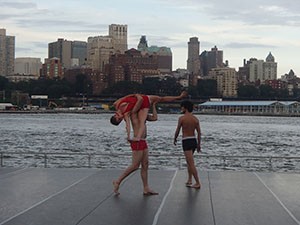
TBDC Dancers Tara Lorenzen, Nick Strafaccia, and Olsi Gjeci perform “I’m going to toss my arms — if you catch them they’re yours” on Pier 15 at the South Street Seaport in NYC.
As an embedded intern with the Trisha Brown Dance Company (TBDC), I worked alongside TBDC administrators and artistic directors, observed the company in rehearsals, befriended the dancers, learned repertory and improvisation/ composition techniques from TBDC alumni, and watched many, many performances. During my internship, I accompanied the dancers and TBDC artistic staff on two trips. This gave me a taste of life on the road for a dancer in an international touring company and allowed me to develop a deep understanding of the diverse performance programs that the Trisha Brown Dance Company presents.
The first stop on my personal tour with TBDC was Annandale-on-Hudson, New York, where the company was invited to perform selections from its Proscenium Works, 1979-2011 tour (the final tour of Trisha’s repertory works specifically choreographed for the stage, coming to Ann Arbor in February). After a NYC performance of “I’m going to toss my arms, if you catch them they’re yours” (fondly referred to by the company as “Toss”), I joined the company in a 15-passenger van headed toward Bard College. Though I was new to the touring artist lifestyle, I quickly learned that this pace is typical for the dancers. In one day, they danced on a pier overlooking the East River, drove upstate from New York City, and prepared for the next round of performances!
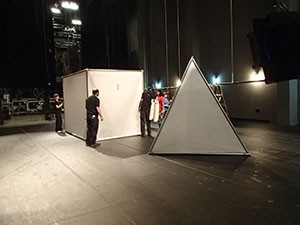
Load-in of Robert Rauschenberg’s set piece for “Set and Reset” prior to the company’s Bard SummerScape performance.
We arrived at Bard late that night. Throughout the weekend, I found myself enchanted by little details of tour life, as mundane as they may seem. I loved the trips to the grocery store to stock up on weekend meal essentials, the hospitality provided by the presenter, and the pre-rehearsal or performance rituals of each individual dancer before they all came together as a group; these helped me recognize touring as a realistic and obtainable aspect of a professional dance career, as opposed to something far-fetched and imaginative.
Even more exciting for me was the opportunity to watch the program in technical rehearsal and performances. The company presented “I’m going to toss my arms — if you catch them they’re yours,” “Set and Reset,” and “If You Couldn’t See Me.” They will bring the latter two to Ann Arbor. Seeing Diane Madden, co-associate artistic director of the company, lead the dancers in onstage rehearsals was like getting a sneak peek at the man behind the curtain before the grand unveiling.
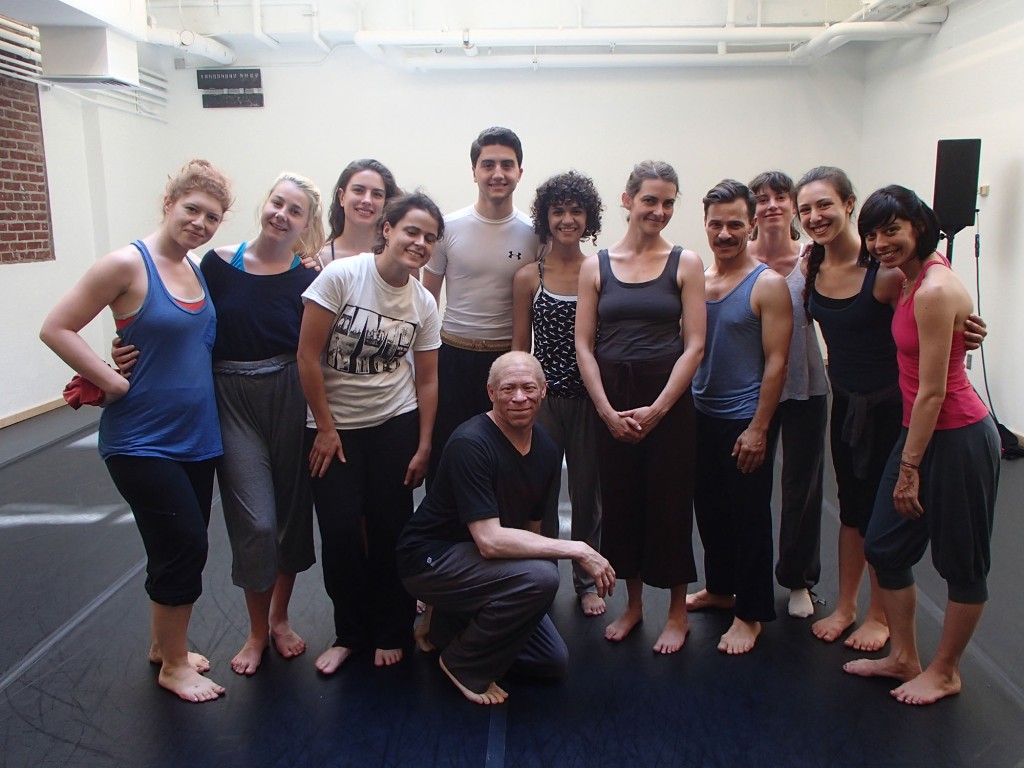
TBDC Summer Intensive students with Company alumnus Keith Thompson.
My impression of the works was further enhanced when I watched them in performance with full costumes, lights, and set. Trisha valued the visual design elements of dances as much as she did the movement — collaborating frequently with artists such as Robert Rauschenberg and Donald Judd — and her choreography breathed a new light with the integration of additional production elements. I saw the program three times, and each time I noticed something new, but also recognized familiar moments or images. I’ve grown to admire this about Trisha’s work: her dances have multiple layers, but follow a cohesive line that runs parallel to the surprising twists and turns.
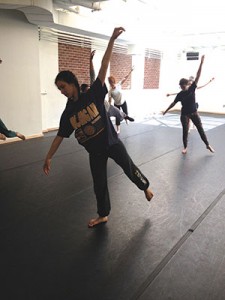
Dancing a part of “Newark” at the TBDC Summer Intensive.
After our weekend at Bard, I parted ways with the company. I returned to New York to serve as the on-site coordinator for the TBDC Summer Intensive, a three-week workshop that offered up to six hours of technique, repertory, and composition classes each day. I acted as a point of reference for students and teachers and was also able to dance! Classes allowed me to further explore the works I had grown to know intimately as an audience member, and to embody the movement that I only saw and read about up until this point. Composition/improvisation class revealed the techniques behind choreographic concepts I had observed in Trisha’s work and allowed me to apply them to my own dance making. Some of what I learned will surely find its way into the work I create for my Senior BFA Concert this coming April!
In August, I reunited with the company for my second tour experience of the summer, a performance of Trisha’s Early Works at the Lynden Sculpture Garden in Milwaukee, WI. Before she began choreographing larger works such as “Set and Reset” for the proscenium stage, Trisha concentrated on shorter, site-adaptive dances for alternative venues such as museums, rooftops, and parks. The company performs these works for events throughout NYC and international tour venues and will continue to concentrate on these types of performances after the conclusion of Proscenium Works, 1979-2011.
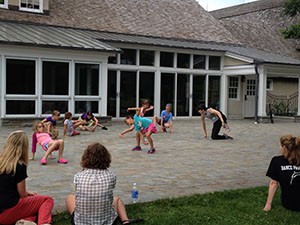
TBDC dancer Tamara Riewe leads young members of Lynden’s summer camp in demonstrating poses inspired by the sculptures in the garden.
This trip to Milwaukee marked my first foray into site work, and I quickly learned how much extra effort must go into presenting dance in any area other than a stage. We spent the first day at the Garden traveling from spot to spot, considering which dances would work best in front of which sculptures, identifying the strongest vantage points, and mapping a path for the audience to travel between locations. Since all the company members were not present for the initial site visit, I often assumed the role of a stand-in to help the team visualize dances in different locations. I was able to try some of Trisha’s choreography and tasks on site, doing her signature “Group Primary Accumulation” while floating on a raft in the middle of a pond and walking down the side of a tree for “Spiral.”
Trisha’s Early Works are full of these fun tasks and were an absolute blast to watch in performance. In one work titled “Sticks,“ dancers moved through a series of postures while balancing long, wooden sticks on their heads. This lighthearted performance atmosphere contributed to the informal relationship established between the dancers and audience. Throughout the performance, the dancers interacted with us, acknowledging when something wasn’t working and inviting us to join in on their fun. This, I discovered, was a delightful difference between the Early Works and Proscenium Works programs, the latter of which demonstrates a traditional separation between performers and audience.

TBDC members perform Sticks at the Lynden Sculpture Garden in Milwaukee, Wisconsin.
Seeing the Early Works really sparked my interest in dance for alternative spaces, which I’ve been exploring since I’ve returned to Michigan. This marks one of the many ways that my travels with the company influenced my impressions of Trisha’s work and view of the dance field. I grew leaps and bounds throughout the summer, but my experience would not have been complete without the opportunity to climb in a van with 11 professional dancers or to walk down the side of a tree in front of the company’s associate artistic director. I began my rich and unique experience as an intern “embedded” with the company, but emerged as a knowledgeable, conversant member of the TBDC family.
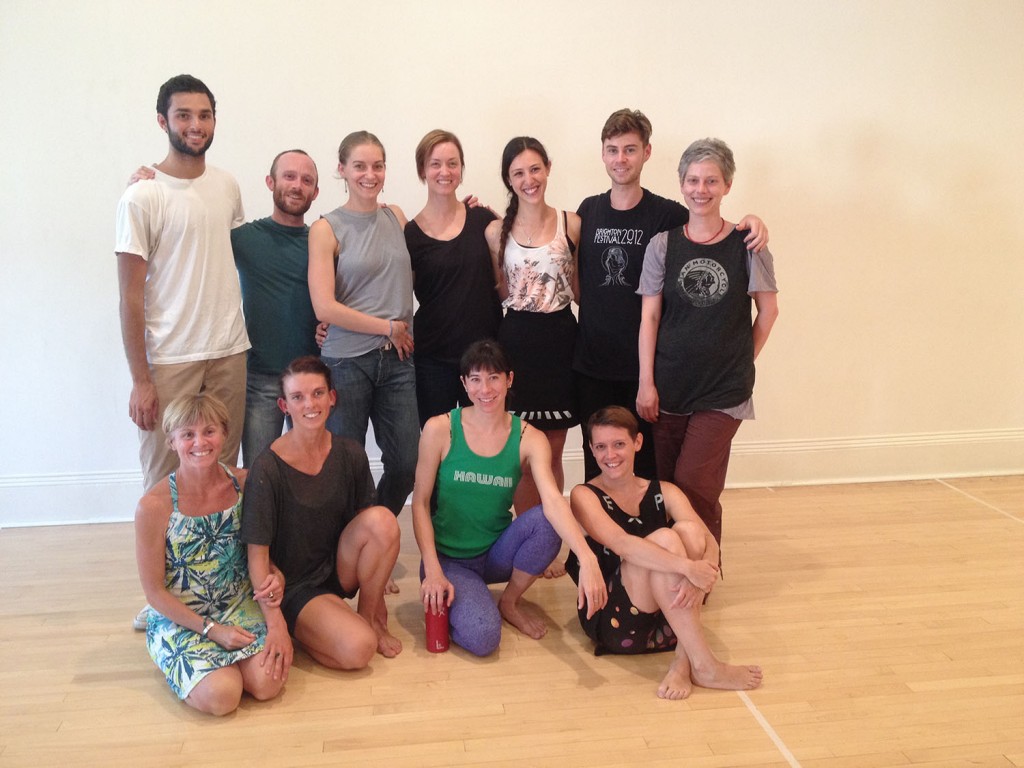
Smiling with Carolyn Lucas, Diane Madden, and the TBDC company members. Thank you for a wonderful summer!


